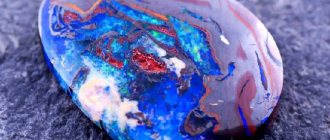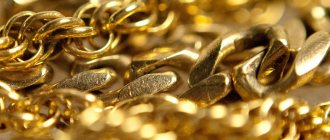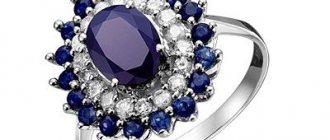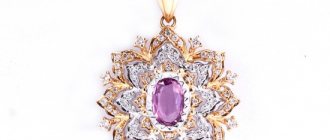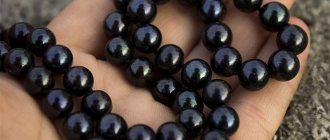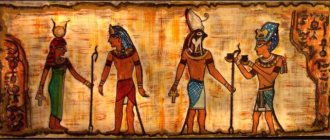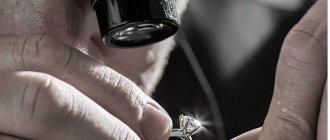Hello, our precious readers! We again continue to explore the world of rare and precious minerals. Today we will talk about such a unique phenomenon as the color of a diamond, which undoubtedly attracts attention in the first place. The color shade affects not only the cost, but also the play of light and the setting of the diamond (if it is inside the jewelry).
We will look at the possible color shades of stones (from transparent and white diamonds to hard Champagne-colored minerals), find out how color is assessed according to the table and according to what system, which colored diamonds are the rarest and many more interesting facts.
What color can a diamond be?
Initially, according to historical data, the first diamonds and diamonds appreciated by the public and jewelers were colorless or transparent.
Over time, fantasy designs began to gain great popularity. That is, pure, rare, hard and beautiful stones, which were an order of magnitude different from their white counterparts.
Firstly, they have great charm. Secondly, their diversity simply defies imagination. Thirdly, they allow you to perfectly combine jewelry frames not only with white gold and platinum, but also with regular yellow. Take, for example, a unique work of art - the famous Tiffany diamond, which only two girls were honored to wear in their lives, and only for a short time.
The main colors in addition to classic transparent diamonds are as follows:
- light yellow and yellow;
- light brown and amber-honey;
- dark brown and black;
- purple (they are now the rarest, mined from deposits in the relatively recently discovered Argyle mine in Australia);
- gray and silver;
- champagne colored stones;
- white specimens;
- bluish and blue;
- lemon and tea petals;
- various other options.
Types of Diamonds
There are primarily types of diamonds: technical and jewelry. In the production of jewelry, only jewelry varieties are used, of which only 15% exist in nature. The lion's share of diamonds falls on technical varieties (85%).
There is also a classification of stones by weight: large, medium and small minerals.
Diamonds also come in different colors. There are no specific names for diamonds; they are named according to their color. List of types of stones:
- Pure water diamonds, as we mentioned above, are transparent and colorless, but are extremely rare.
- The yellow diamond type is the most common. Yellowness occurs in them of varying degrees of severity.
- Red diamonds are highly valued. Their deposit is in Australia, the deposits of red diamonds are very deep in the ground.
- In these same Australian deposits, pink diamonds are more common than red diamonds.
- Brown diamonds are also called cognac, amber, champagne and chocolate colored stones.
- Blue diamonds are found due to the presence of boron in their composition.
- Blue diamonds are rare and are considered valuable and noble.
- The origin of green diamonds is possible due to prolonged exposure to radiation.
- Black diamond is found in the upper layers of the earth's crust and is also beautiful and durable.
What can color and shade depend on?
There are several factors that influence the hue and color characteristics of beautiful and unique minerals.
- Firstly, these are natural factors. Beautiful and rare mineral samples lie in the depths of our planet and are formed over tens of thousands of years. Constant pressure, the influence of temperature changes, the depth of occurrence and the presence in the specimen itself and in its surroundings of impurities in the form of dust, fragments and other elements of other ores (for example, iron) add richness to the shade or can completely change the color of the diamond, while leaving the famous color for the whole the world is the hardness of a diamond.
- Secondly, the distance between the molecular compounds in the crystal lattice of the precious solid stone formation. If the distances between the elements are smaller, then the mineral looks more “saturated” in color.
- Thirdly, the purity of the diamond, and then the cut miracle - the diamond. The rarer the stone, the purer it is, the better its dispersion characteristics and the nature of the mineral better conveys shade and saturation with as few inclusions and defects as possible.
- Fourthly, this is the direct process of cutting, polishing, and polishing a rare, hard, beautiful diamond. Thanks to the skillful efforts of the jeweler, unnecessary parts are cut off, painstaking work is done, sometimes taking more than one week or more than one month.
The result is not only a beautiful and unique masterpiece, but also the most saturated color shade of the diamond.
- Fifthly, there are modern methods that help improve the color and shading qualities of jewelry.
One of them is the effect of high pressure and temperature on the product. In essence, this is an attempt to repeat the conditions that nature itself did, but in a much shorter period of time and affecting only the color factor, while leaving other parameters untouched. Naturally, this method is very popular and only affects the color change.
- Sixthly, another modern method is the exposure of a solid diamond specimen to radioactive radiation. The action takes place in a nuclear reactor. When radioactive particles pass through a mineral, they interact with the molecules of the crystal and a subsequent reaction, which is enhanced or reduced only by the color saturation up or down to the required level.
After such exposure, the sample does not become radioactive, so there is no need to be afraid that it will pose a threat and danger. After this procedure, it is carefully checked in laboratory conditions for the absence of radiation.
Color or clarity: which to choose?
The value of a diamond is determined by its brilliance; Color and clarity do not directly affect the brilliance, but can visually emphasize the luxury of the crystal. Colorless stones seem to be the brightest and most vibrant, and a pronounced yellow tone makes the gem dark and less shiny.
Choosing jewelry is not an easy task
Cleanliness makes an impression if imperfections are not visible to the naked eye. Visible imperfections create a feeling of dirt, although they do not change the way light is reflected. The shine deteriorates if there are large inclusions, but such specimens do not reach jewelers.
Experts believe that high quality color is more important than how pure the stone is. This is especially significant if the crystal is supposed to be framed with metal - the natural color is enhanced by the frame.
Global 4C rating system from GIA
The most complex assessment system is the Russian one, as it includes a lot of assessment parameters.
There are several generally accepted systems for assessing the quality of diamonds. “4C” is the most famous system. It is considered the most accurate and universal. It was proposed by the Gemological Institute of America, where it was developed. This is where the assessment happens. Or in partner organizations that have direct permission to do so.
This grading system allows you to make the maximum assessment of any solid, clean and beautiful diamond according to its main parameters:
- carat weight or the mass of a diamond stone, measured in carats (1 carat is 0.2 grams). A fundamental indicator on which the cost and immediate future of a beautiful stone depends;
- color or color of the stone. Some experts in geology and gemology consider it "superfluous." But this is not so, because even an original and seemingly transparent stone can have its own slight tint, which will give it much greater value and significance along with its similar representatives. A special table is used to evaluate this parameter. We will look at how to determine and evaluate using this table a little later.
- clarity or purity of the stone. Hidden defects and small inclusions under a tenfold magnification under a microscope will be exposed in any diamond. The specimen is inspected and compared with standards. After this, it is assigned a grade determined by an expert according to a grading table, similar in structure to the system for grading the color and shade of a diamond;
- cut or faceting. The last parameter in the evaluation. Subjective. Helps determine the most accurately carried out work on a stone by its cutting, subsequent grinding and polishing of the edges. Depends on the experience of the jewelry maker.
The above-described system allows, among many diamonds, to bring each of them to common “parameters” for much greater “versatility” and a more accurate determination of value.
How and why to buy a colored diamond?
Is it worth the risk when choosing a colored diamond? You must answer this question for yourself. Let me clarify that colored diamonds grow in price the fastest. In the near future we can expect a significant increase in prices for such stones. The fact is that over the past 15 years, the production of colored diamonds has decreased greatly. That is why they are interesting from an investment point of view. For example, the price of pink diamonds has increased the fastest - by 385% over the past 10 years. They are followed by fancy yellow diamonds at 322% over the same period. The cost of orange and green diamonds increased by 276% and 230% respectively. The cost of blue diamonds also grew slowly but steadily—by 183% over 10 years. But colorless diamonds have increased in price by 72% over 10 years. It is likely that the situation may repeat itself in the next decade.
How, then, to purchase a colored stone correctly? Firstly, it is strongly recommended to leave Russia and go to one of the diamond capitals of the world - for example Tel Aviv, Hong Kong, Antwerp or Mumbai. The fact is that in Russia most stones are sold without a GIA certificate, which allows stores to inflate the characteristics of the stone and, accordingly, the price several times. Already on the spot, it will not be difficult for you to find a reliable broker who will present you with a choice of several stones with a GIA certificate and provide expert support during the purchase process.
Colored stones with pure colors and good characteristics can make a wonderful gift and an excellent tool for preserving wealth. The main thing is to be aware of all possible dangers and carefully study the market offers.
What color is a diamond or how is it graded according to the table?
Evaluation by color shade is the second “C” and is carried out using a special table and the presence of standard stones. Even an ordinary, seemingly at first glance, diamond has its own unique shade. The table is shown below. Even an inexperienced lover of the wonderful world of beautiful and rare stones can understand it, but we will still explain it a little.
- The characteristic displayed in the table as “Specification up to 0.29 ct” means small stones weighing up to 0.29 carats, and the inscription “Specification from 0.30 ct” means medium and large diamonds weighing from 0.3 carats and above. mass.
To evaluate a rare precious mineral as accurately as possible, standard stones are used, with which the beautiful stone being studied is compared. The closer he is to a particular standard, the faster he will be assigned this particular class.
- Each group in the color shade table is headed by a letter of the English alphabet. D is a colorless “standard” hard stone, and Z is a yellow standard. That is, both color and its saturation are taken into account at the same time. The richness of the color of a beautiful gemstone depends not only on the purity of the mineral, but also on the structure of the crystal lattice.
As mentioned above, the denser the lattice and the smaller the distance between the carbon molecules, the more saturated the color of the stone. Let’s not forget about inclusions that may occur due to the ingress of iron dust or other particles of known minerals.
- Numbers 1-9 indicate how pure the diamond is. It is logical that, first of all, the purity of the mineral is assessed. After all, if a stone that is beautiful at first glance initially has strong visible and invisible defects, then the color saturation is immediately lost and will no longer be considered ideal.
There is no such thing as “not suitable” in the color characteristics of a diamond. The assessment, although subjective, helps to assign the most suitable class to the sample being studied among a wide variety of unique color shades and saturation.
After the examination of the “color component” and shade, the values are recorded and logged in the database of the organization that conducted the examination. This parameter is also specified in the gemstone certificate, which guarantees that what is written corresponds to what is seen.
The assigned color grade can significantly affect the value of a piece and will allow it to “rise or fall” among its peers in this cut-throat world of harsh and merciless grading.
- The diamond is appraised without a setting. Before the examination, the hard stone is very carefully pulled out of the frame and only then sent for examination. At this time, the frame can simply be stored in a safe place, or it can undergo restoration work - depending on the condition and wishes of the customer.
The rarest fancy diamonds today
Quite a lot of time has passed since the first diamond was found and cut. Many worthy, rare and pure works of natural and jewelry art were found. Therefore, a lot has changed.
Today, silver stones are beginning to gain great popularity, as well as rare examples of a purple hue and color, which are found in relatively small quantities on the Australian continent.
We can also mention and make a forecast that natural black diamonds will soon also increase in price and become even more in demand, because the deposits are almost exhausted. Although new deposits are currently being explored, their discovery is not expected in the coming years.
Gradation of intensity
It is generally accepted that precious minerals have nine color intensities, namely (if considered in order of increasing from least to greatest):
- insignificant;
- weak;
- low-fantasy;
- fantasy;
- intense fantasy;
- intensely fantasy;
- bright fantasy;
- unusual bright;
- bright, intensely fantasy.
Naturally, the higher the class, the more valuable the copy.
How is color formed?
To understand what the color of a diamond can be, you should consider the composition of this stone. The diamond mineral is almost 99% pure carbon, but 1% of the stone’s composition includes other elements: chromium, manganese, boron, silicon, etc. It is the impurities that determine the shade of the diamond. In nature, the bulk of the volume of mined diamonds comes from colored stones, while colorless diamonds are considered quite rare.
The color of diamonds is characterized by unevenness, however, every stone created by nature has this feature. There are also diamonds that combine several colors at once. As for the color intensity of the stone, diamonds are characterized by pale tones.
Considering what the colors of a diamond are, it does not hurt to divide all diamonds based on their scope of application. What types of diamonds are there?
- Jewelry: Stones that are suitable for use in diamond production account for only 15% of total diamond production. Minerals that can be cut into diamonds must have perfect clarity. The most common shades of such stones are yellow, brown and smoky. Due to their rarity, purple, pink and green diamonds are highly prized.
- Technical: the bulk of diamond production comes from stones that are used in other areas of production. Industrial diamonds are characterized by complete opacity. The most popular varieties of such stones are carbido, ballas, and carbonado.
Diamond became one of the most valuable stones after its physicochemical properties were studied in detail, and this happened around the sixteenth century. Since then, diamonds have become associated with luxury and high material status. Today, jewelry stores, various repair products, cosmetics, and even computer games are named after diamonds. An example of this is the game Chameleon Diamonds, a 3D version of the popular game Zuma. The virtual entertainment consists of hundreds of puzzles in which you can accumulate and explode shining diamonds according to the rules of the game.
Diamonds are processed diamonds
In nature, there are other minerals that are very reminiscent of diamond in appearance - these are rock crystal, white topaz, leucosapphire, etc. Often, fake diamonds are made from these stones, for example, from crystal.
How does color grading work in Russia?
The most complex system that takes into account many more factors compared to the same world ones. The complexity arises from the fact that there are many more evaluation parameters. It has a rather short name - TU 117-4.2099-2002
If we ask only the question of determining the color component, then in our version we consider 3 scales:
- I-scale – for diamonds with 17 facets;
- II-scale – for products with a cut of 57 facets, the weight of which is less than or equal to 0.29 carats;
- III scale - also for samples with a cut of 57 facets, the weight of which is greater than or equal to 0.30 carats.
In the first scale, there is a division into four color groups. In the second there are seven groups, and in the third all nine. Quite a significant difference compared to the same American GIA system in a more complex direction.
It should be noted that for greater convenience, a comparative analysis of various world-class jewelry valuation tables has been carried out. Special tables have been created that allow you to convert data from one to another.
Assessment systems
Diamonds are graded according to a generally recognized scale accepted throughout the world. When analyzing a stone, its color, weight, purity and processing are taken into account. There are several assessment systems adopted in individual countries and regions. They also categorize stones based on 4 main parameters, but classify colors differently. The Russian assessment system has been adopted in Russia. In general terms, it does not contradict the world one, but it has a number of differences.
The main grading system is American, developed by the Gemological Institute. The scale is named GIA after this institution. The Institute is currently the main point for working with diamonds. GIA specializes in the study of crystals, the development of methods for creating stones in the laboratory, and the evaluation of gems. In addition to diamonds, GIA scientists work on pearls and other gemstones. The institute was created with the aim of protecting buyers from scammers and is aimed at providing laboratory services, documentation, and increasing the level of knowledge about stones among the general population. GIA is a leader in gemology and laboratory testing of stones. The results of analyzes done at the institute are universally accepted. Thousands of stones pass through laboratories every year. A special task of the institute is the research of new synthetic stones after they appear on the market.
There are several scales for rating crystals
If the crystal is GIA certified, re-evaluation under the local system is not required. Although classifications vary, it is enough to use conversion tables to interpret the result on a different scale.
What to consider when buying diamonds
Purchasing a jewelry diamond is not an easy task. Based on the quality scale, it is easy to determine which copies are better than others, but not everyone can buy them. Finding a beautiful, clean, colorless, yet inexpensive stone is not an easy task.
Experts recommend buying diamonds with small defects - imperfections that are visible only under high magnification. Preference is given to diamond color. Colorless stones are not available to ordinary buyers, so the optimal solution is minerals from color class F. It will not be possible to distinguish this group of stones from more expensive ones without a special examination with standards.
